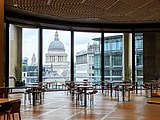Bloomberg London
Design and build
The building was designed by architects Foster and Partners with structural engineer AKT II, and constructed by Sir Robert McAlpine at a cost of £1bn. It consists of two buildings, divided by a covered arcade. The buildings are linked by bridges. The arcade contains several restaurants, and reinstates part of Watling Street, an ancient Roman road. Prior to construction, archaeological digs at the construction site yielded a collection of Roman-era inscribed wooden writing tablets now known as the Bloomberg tablets.
The building is clad in 9,600 tonnes of Derbyshire sandstone with bronze ventilation fins. Inside, the floors are linked by custom glass lifts and a 210m helical bronze "ramp", which dominates the interior of the building. The cores of the building are on the outside, to create a single open-plan space inside. Express lifts take visitors from the lobby, a self-supporting "vortex" of three curved timber shells, to the double-height pantry on the sixth floor, with view of St Paul's Cathedral. Then visitors must take a second lift or use the ramp to access other floors. The building houses 4,000 staff, with room to expand. All desks are electric adjustable-height.
The building features artwork by Olafur Eliasson and other artists. Outside, there is a three-part sculpture called "Forgotten Streams" by Cristina Iglesias, which evokes the Walbrook river.
In 2018, the RIBA awarded the Stirling Prize to Bloomberg London.
Energy usage
The building is noted for its energy-efficiency. It achieved a 98.5% score against the BREEAM sustainability assessment method, the highest design-stage score ever achieved by any major office development. Rainwater is collected from the roof to supply the vacuum toilets. The office floors are illuminated with 500,000 LEDs. The ceilings are custom aluminium "petals", inspired by the pressed metal ceilings of New York, which act as light diffusers, cooling elements and acoustic attenuation.
The design and building process of the building has been criticised as wasteful: it required developing specialised solutions not applicable anywhere else, and the construction required 600 tonnes of Japanese bronze and 10,000 tonnes of imported Indian granite, rather than using locally sourced or recycled materials.
Bank Tube station entrance
As part of the construction of the building, a new entrance to London Underground's Bank and Monument station complex was built. This provides direct access to the Waterloo & City line via four new escalators and two lifts – providing step free access for the first time. Construction of the new entrance began in November 2015, and the new entrance was officially opened by Mayor of London Sadiq Khan and former Mayor of New York Michael Bloomberg in December 2018.
The new entrance incorporates etched glass panels by artist John Hutton, depicting 66 figures based on the ancient Roman history of the area, including the Roman Temple of Mithras. The artwork was originally completed in 1962 on Bucklersbury House, the post war office building previously located on the site.
Mithraeum
The building is on top of the site of the London Mithraeum, the remnants of a Roman temple. The Mithraeum was relocated to a different site in 1962, but as part of the construction of Bloomberg London it was relocated to close to its original site. It is open to the public.
The building also contains the Bloomberg Space, which displays artworks.
Gallery
-
The main lobby or "vortex", with the artwork No future is possible without a past by Olafur Eliasson
-
Part of the central ramp on the upper floors
-
Looking down on the central ramp and lower floors
-
Office space, highlighting the aluminium ceiling "petals"
-
The double-height "pantry" space, with a view of St Paul's Cathedral
-
A cutaway model of the building
References
- ^ Moore, Rowan (29 October 2017). "Bloomberg European HQ review – welcome to the Bloombergeum…". The Guardian.
- ^ Wainwright, Oliver (25 October 2017). "Bloomberg HQ: a £1bn building that looks like a regional department store". The Guardian.
- ^ "Bloomberg London Building". Bloomberg L.p. – via www.bloomberg.com.
- ^ "Bloomberg HQ in London wins Riba architecture prize". BBC News. 10 October 2018. Retrieved 11 October 2018.
- ^ "Foster's Bloomberg headquarters is "world's most sustainable office"". dezeen.com. 4 October 2017.
- ^ Merin, Gili (1 November 2018). "הבניינים האלה נחשבים "ירוקים". אבל האם באמת יש דבר כזה בנייה ירוקה?". הארץ (in Hebrew). Retrieved 3 November 2018.
- ^ Wainwright, Oliver (25 October 2017). "Bloomberg HQ: a £1bn building that looks like a regional department store". Retrieved 3 November 2018.
- ^ "Bank station: work starts on a new entrance". Transport for London. 5 November 2015. Archived from the original on 1 February 2016. Retrieved 12 April 2020.
- ^ "New Waterloo & City line entrance relieves congestion at Bank station". Transport for London. 12 December 2018. Archived from the original on 12 April 2020. Retrieved 12 April 2020.
- ^ "Bucklersbury House, City of London". recclesia.com. Retrieved 12 April 2020.
- ^ "London Underground displays the Hutton Panels inside Bank station". www.ianvisits.co.uk. Retrieved 27 November 2022.
- ^ Kennedy, Maev (8 November 2017). "Reconstructed Roman Temple of Mithras opens to public in London". The Guardian.





